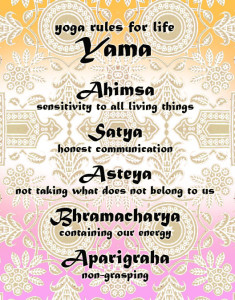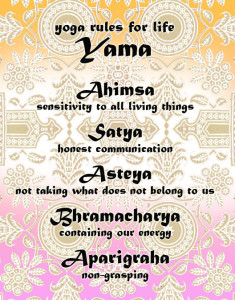Spotlight on Limb 1: The Yamas

The first of the eight limbs of yoga is the yamas. The yamas are the physical restraints or ethical guidelines for embarking upon the yogic path.
Before we continue, I want to make something clear.  These yamas (and all 8 limbs, for that matter) are to be taken as guiding principles. The truth is, it is very difficult (if not downright impossible!) to uphold these yamas constantly. At best, they serve as ideals to aspire toward and to guide our actions. We may have periods of our lives in which we are better able to adhere to these principles than others. But as long as we sincerely try our best to live up to these ideals, we are on the yogic path.
So, without further ado, the 5 yamas are:
1. Ahimsa, or nonviolence/non-harming. This applies to other humans and other living creatures, including animals. However, ahimsa goes beyond non-harming of other creatures; rather, it extends toward the self as well.  So, part of practicing ahimsa is to be kind and compassionate toward oneself and others.  Practicing ahimsa helps us become more aware of the peaceful qualities of all beings, and it encourages us to honor that peace above anything else.
2. Satya, or truthfulness.  According to satya, we view and describe the world based on how it actually is, instead of how we want it to see it.  This may mean that we have to admit when we’re distorting reality to avoid confronting a painful truth.  In practice, satya may involve speaking an uncomfortable truth with compassion rather than falsely telling others what they want to hear to avoid hurting their feelings.
3. Asteya, or non-stealing.  This includes not only objects, but also the time, resources, information, and caring that others provide.  In practice, asteya may look like being aware of when someone is generously giving us their time, and being mindful not to take advantage of their generosity.  It may also involve us “paying it forward” by donating our time or resources to others without expecting anything in return.
4. Brahmacharya, or moderation of the senses.  Brahmacharya involves looking inward for balance, rather than depending on the outer world to satisfy our cravings.  That way, we use our energy more wisely for the activities that sustain our inner peace.  For example, maybe you have an unwinding ritual at the end of a long, hard day – eating ice cream while watching reality TV shows (no, I’m definitely NOT speaking from experience…).  While it may seem totally innocuous, you might become dependent on this activity for peace and normalcy, such that when you run out of ice cream or your power goes out, you’re annoyed and feel off-kilter for the rest of the night.  Consider finding another way to recharge that involves turning inward and withdrawing from the senses – perhaps by dedicating some of that time to a meditation practice.

